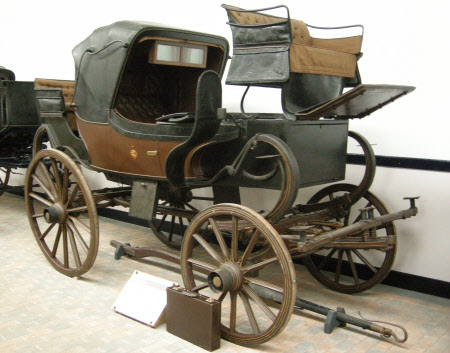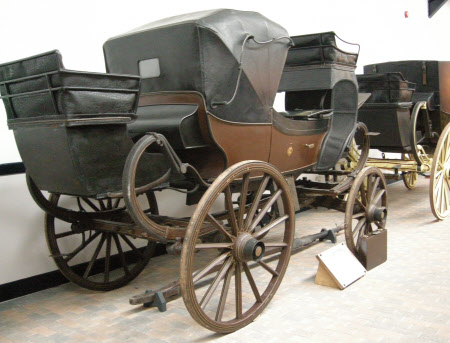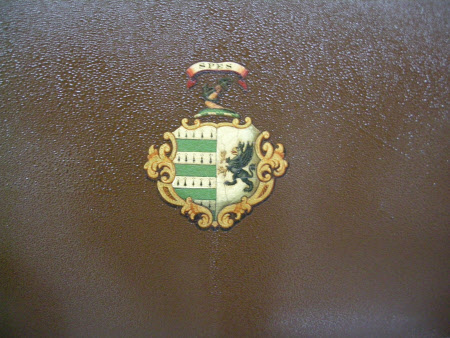Britzschka
Tapp & Co
Category
Carriages & other vehicles
Date
circa 1810 - 1840
Materials
Painted wood body with wool cloth upholstery and four iron shod wheels.
Measurements
237 x 392 x 185cm (7ft 9 1/4in x 12ft 10 1/3in x 6ft 3/4in)
Place of origin
London
Order this imageCollection
National Trust Carriage Museum
NT 272957.1
Caption
This carriage reputedly travelled from Chester to Rome and back in the early 19th century; we are investigating possible owners. The name comes from the Polish word for travelling wagon. This type of carriage was introduced to Britain via Germany in the 1820s and was popular with wealthy families because of their adaptability. It has many similar features to the Travelling Barouche apart from the body shape. It has the useful addition of a silk sun visor, as can be seen in this picture, and a large boot, under the removable coachman’s seat, for luggage. Only two original Britzschka’s are known to have survived in Britain making this one very important.
Summary
Britzschka built in the early 19th century by Tapp & Co London. Britzschka (four wheels) for a team of horses. The body is sprung on C springs with no under springs. The side panels have ogee back ends and concave front ends. The boot is framed to the front of the body with a removable coachman’s seat and footboard mounted on the boot. There is a hind boot with a rumble seat bolted to the hind footboard. A sword case is on the back of the body. Interior upholstered in brown wool cloth. Painted black and brown with yellow lining.
Full description
The word Britzschka comes from Poland where the original britzschkas were travelling wagons. They were refined in Western Europe and introduced into Britain in the eighteen twenties, where they became the most popular of travelling carriages until the advent of the railways made them redundant. A britzschka has the same configuration as a barouche – an open body with the principal seat at the back protected by a folding leather head (carriage terminology for hood), and an additional seat at the front of the body which is accessible when the knee flap is hinged up in fine weather to form its seat back – but whereas a barouche has a canoe-shaped body, the body of a britzschka has a straight, or nearly straight, bottom line and the end panels are either concave or ogee shaped. The earliest britzschkas were suspended on C springs, and under springs were added soon after they were introduced. Although some britzschkas could be fitted with a coachman’s seat so that they could be driven in town, they were principally used as travelling carriages and were therefore postillion-driven. In this configuration they had a rumble seat behind the body to carry two servants, usually a valet and a lady’s maid, and some of them had a dormeuse boot so that the occupants could lie at full length and sleep while they travelled. The name became spelt in many ways including the anglised versions ‘brisker’ or ‘brisky’, popular with ostlers and post boys who had trouble pronouncing and spelling the original name. They were used by wealthy families for travelling at home and abroad, including the Grand Tour of European cities of cultural interest, also by King’s Messengers travelling from London to our foreign embassies when speed was all-important, and occasionally for business travel. Later in the 19th century when travelling carriages had been driven off the road by the railways, smaller versions were produced suspended on elliptic springs, sometimes small enough to be pulled by one horse, but these had none of the character of the fine and impressive britzschkas of twenty or thirty years earlier.
Marks and inscriptions
On front nearside axle cap.: TAPP & CO On front offside axle cap.: TAPP & CO On rear nearside axle cap.: TAPP & CO On rear offside axle cap.: TAPP & CO Science Museum Inventory No:1936-592 On front nearside axle components. : F THRUPP LONDON On front offside axle components.: F THRUPP LONDON On rear nearside axle components.: F THRUPP LONDON On rear offside axle components.: F THRUPP LONDON
Makers and roles
Tapp & Co, coach builder


